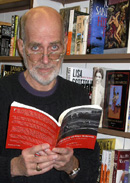
Milestones
{An Umbrella Invitational}

Milestones
{An Umbrella Invitational}

Philip Dacey’s
nine full-length books include The New York Postcard Sonnets: A Midwesterner Moves to Manhattan (Rain Mountain Press, 2007) and The Mystery of Max Schmitt: Poems on the Life and Work of Thomas Eakins (Turning Point, 2004). The most recent of his dozen chapbooks is Three Shades of Green: Poems of Fatherhood (Snark, 2006). He’s received three Pushcart Prizes, two NEA creative writing fellowships, and a Fulbright to Yugoslavia. —Back to Milestones Contents— |
Rondel
A beautiful snow falls on a bed, Originally published in College English and in How I Escaped From the Labyrinth and other Poems (Carnegie-Mellon U. Press, 1977).
Artist’s StatementI
n 1975, I took my wife and two young sons from Minnesota, where I was
teaching after having acquired my M.F.A. from the Iowa Writers’ Workshop in
1970, to Spain, where I set up for myself a writing regimen focused on
teaching myself about the traditional poetic forms. As much as I appreciated
my time in Iowa City, I was struck by the fact that during my two-year
tenure there, I received absolutely no instruction in traditional forms in
any class. I decided early in the 70’s that if traditional form was good
enough for the likes of moderns like Yeats and Frost, it surely ought to be
good enough for me. So each morning during our six-month stay in Madrid and
Altea, I studied and practiced traditional forms. “Rondel” was the first
traditional form poem I completed. |
||
|
|
|||